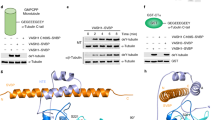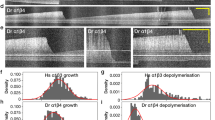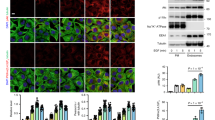Abstract
The adenylate cyclase system, which mediates cellular responses to a variety of hormones and neurotransmitters, contains at least three plasma membrane-associated proteins: the hormone receptor, the regulatory or guanyl nucleotide-binding unit (G unit) and the catalytic moiety. Activation of the enzyme after binding of hormone to the receptor involves binding of GTP to the G unit1. Activation can be enhanced by increasing the fluidity of the membrane with unsaturated fatty acids2 with the local anaesthetic prilocaine3, and perhaps, in vivo, by phospholipid methylation4. Disruption of microtubules increases localized mobility of membrane proteins in a manner similar to that of unsaturated fatty acids5 and can enhance cyclic AMP accumulation in intact leukocytes6–9. We therefore decided to investigate whether there is a direct interaction between micro-tubules and adenylate cyclase. We show here that colchicine, vinblastine and cis- unsaturated fatty acids enhance G unit-mediated activation of adenylate cyclase, implying that microtubules or tubulin are involved in the attachment of the G unit to the membrane.
This is a preview of subscription content, access via your institution
Access options
Subscribe to this journal
Receive 51 print issues and online access
$199.00 per year
only $3.90 per issue
Buy this article
- Purchase on Springer Link
- Instant access to full article PDF
Prices may be subject to local taxes which are calculated during checkout
Similar content being viewed by others
References
Rodbell, M. Nature 284, 17–22 (1980).
Hanski, E., Rimon, G. & Levitzki, A. Biochemistry 18(5), 846–853 (1979).
Houslay, M. D. et al. Biochem. J. 190, 131–137 (1980).
Hirata, F., Strittmatter, W. J. & Axelrod, J. Proc. natn. Acad. Sci. U.S.A. 76, 368–372 (1979).
Klausner, R. D., Bhalla, D. K., Dragsten, P., Hoover, R. L. & Karnovsky, J. J. Proc. natn. Acad. Sci. U.S.A. 77, 437–441 (1980).
Rudolph, S. A., Greengard, P. & Malawista, S. E. Proc. natn. Acad. Sci. U.S.A. 74, 3404–3408 (1977).
Rudolph, S. A., Hegstrand, L. F., Greengard, P. & Malawista, S. E. Molec. Pharmac. 16, 805–812 (1979).
Insel, P. A. & Kennedy, M. S. Nature 273, 471–473 (1978).
Kennedy, M. S. & Insel, P. A. Molec. Pharmac. 16, 215–223 (1979).
Iversen, L. Neurochemistry 29, 5–12 (1977).
Daly, J. in Cyclic Nucleotides in the Nervous System (Plenum, New York, 1977).
Ross, E. M. & Gilman, A. G. A. Rev. Biochem. 49, 533–564 (1980).
Wilson, L. & Friedkin, M. Biochemistry 5, 2463–2468 (1966).
Shinozawa, T., Sen, I., Wheeler, G. L. & Bitensky, M. W. J. supramolec. Struct. 10, 185–190 (1979).
Bitensky, M. W., Wheeler, G. L., Yamazaki, A., Rasenick, M. M. & Stein, P. in Molecular Mechanisms of Photoreceptor Transduction (ed. Miller, W. H.) (Academic, New York, in the press).
Fung, B. K. K., Hurley, J. B. & Stryer, L. Proc. natn. Acad. Sci. U.S.A. 78, 152–156 (1981).
Uchida, S., Wheeler, G. L., Yamazaki, A. & Bitensky, M. W. J. cyclic Nucleotide Res. 7, 95–104 (1981).
Brostrom, M., Brostrom, C., Breckenridge, B. & Wolfe, D. Adv. Cyclic Nucleotide Res. 9, 85–99 (1978).
Colard, O., Kervabon, A. & Roy, C. Biochem. biophys. Res. Commun. 95, 97–102 (1980).
Whetton, A. D. & Houslay, M. D. FEBS Lett. 111, 290–293 (1979).
Pfeuffer, T. J. biol. Chem. 252, 7224–7234 (1977).
Krishna Bhat, M., Iyengar, R., Abramowitz, J., Bordelon-Riser, M. E. & Birnbaumer, L. Proc. natn. Acad. Sci. U.S.A. 77, 3836–3840 (1980).
Pecker, F. & Hanoune, J. J. biol. Chem. 252, 2784–2786 (1977).
Bhattacharyya, B. & Wolff, J. Nature 264, 576–577 (1976).
Rasenick, M. M. & Bitensky, M. W. Proc. natn. Acad. Sci. U.S.A. 77, 4628–4632 (1980).
Gray, E. & Whittaker, V. J. Anat. 96, 79–88 (1962).
Brown, B., Ekins, R. & Albano, J. Adv. Cyclic Nucleotide Res. 2, 25–40 (1972).
Gilman, A. G. Proc. natn. Acad. Sci. U.S.A. 67, 305–312 (1970).
Kühn, H. Nature 283, 587–589 (1980).
Author information
Authors and Affiliations
Rights and permissions
About this article
Cite this article
Rasenick, M., Stein, P. & Bitensky, M. The regulatory subunit of adenylate cyclase interacts with cytoskeletal components. Nature 294, 560–562 (1981). https://doi.org/10.1038/294560a0
Received:
Accepted:
Issue Date:
DOI: https://doi.org/10.1038/294560a0
This article is cited by
-
A novel peripheral biomarker for depression and antidepressant response
Molecular Psychiatry (2022)
-
Linoleic acid: Is this the key that unlocks the quantum brain? Insights linking broken symmetries in molecular biology, mood disorders and personalistic emergentism
BMC Neuroscience (2017)
-
Mechanical modulation of cardiac microtubules
Pflügers Archiv - European Journal of Physiology (2011)
-
Lipid raft microdomains and neurotransmitter signalling
Nature Reviews Neuroscience (2007)
-
Review author's response: pitfalls in isolating lipid rafts
Nature Reviews Neuroscience (2007)
Comments
By submitting a comment you agree to abide by our Terms and Community Guidelines. If you find something abusive or that does not comply with our terms or guidelines please flag it as inappropriate.



